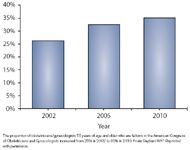An evolving specialty confronts workforce changes
Like many other specialties in medicine, the field of obstetrics and gynecology faces numerous workforce challenges.
Like many other specialties in medicine, the field of obstetrics and gynecology faces numerous workforce challenges. The demand for services is rising, the supply of physicians remains relatively constant, and gender and generational changes are having a significant impact on the culture of practice. In addition, geographic maldistribution of physicians continues to plague ob/gyn as it does many other medical specialties. Furthermore, both the impending changes in healthcare delivery and the ever-present need to contain costs can influence an evolving workforce.
Anticipated physician shortage
The academic medical community recognizes the need for an increased number of physicians in this country. In 2006, the Association of American Medical Colleges (AAMC) called for a 30% increase in graduates from medical schools in the United States. According to a recent AAMC report, first-year medical school enrollment will be 23% higher in 2014 than it was in 2002.1 Residency training positions, which are the prerequisite for practice, have grown slowly-about 1% per year-albeit mostly in primary care fields, and have not kept pace with either population growth or allopathic and osteopathic medical school enrollments.2

Several recent reports predict a likely shortage of physicians in at least 21 medical and surgical specialties.6 Separate studies were conducted by the federal government3 and the AAMC's Center for Workforce Studies.7
The AAMC study examined various scenarios related to the change in supply and demand for physicians in the future.7 Under the "most plausible scenario," the investigators projected a shortage of 159,300 physicians by the year 2025.7 It is noteworthy that these projections assume supply equals demand in the base year, yet we know that 65 million Americans reside in areas designated by the Health Resources and Services Administration as "health professional shortage areas."8
The potential ramifications of a physician workforce shortage in ob/gyn could be profound. Specific sectors of our specialty, including urogynecology and oncology, might consequently require improved access to care.9 A vicious cycle could ensue if physicians, compelled to see more patients or work longer hours to meet patient service needs, decide to eliminate certain aspects of their practice. For example, the aging population will require increased healthcare services, which would consequently affect the field of gynecology, depending on the practice type. Older patients are likely to have an increased need for the management of urinary incontinence, pelvic organ prolapse, and gynecologic malignancies.
Professional liability also must be considered in the future workforce equation. According to the 2009 ACOG Survey on Professional Liability, between 2006 and 2008, 30.2% of physicians reported that they had decreased the number of high-risk obstetric patients that they treated and 8% stopped practicing obstetrics altogether because of the risk or fear of professional liability claims or litigation.10
